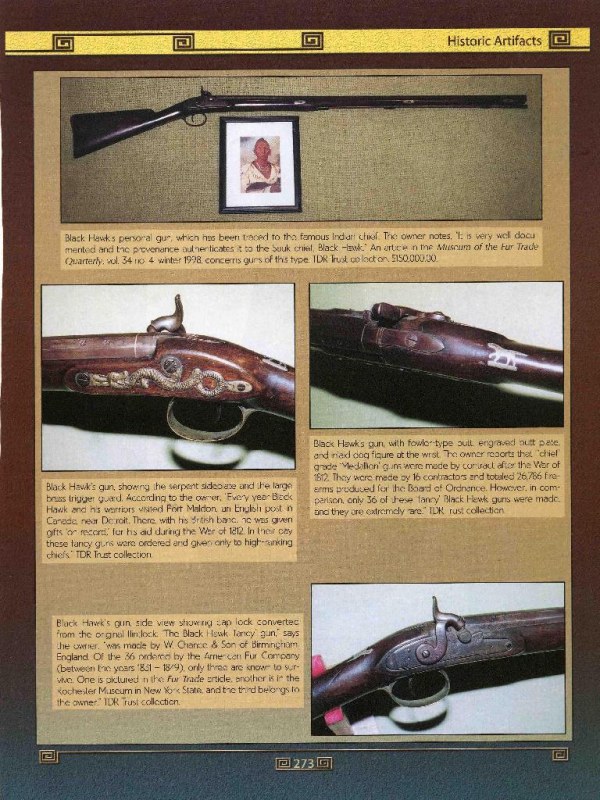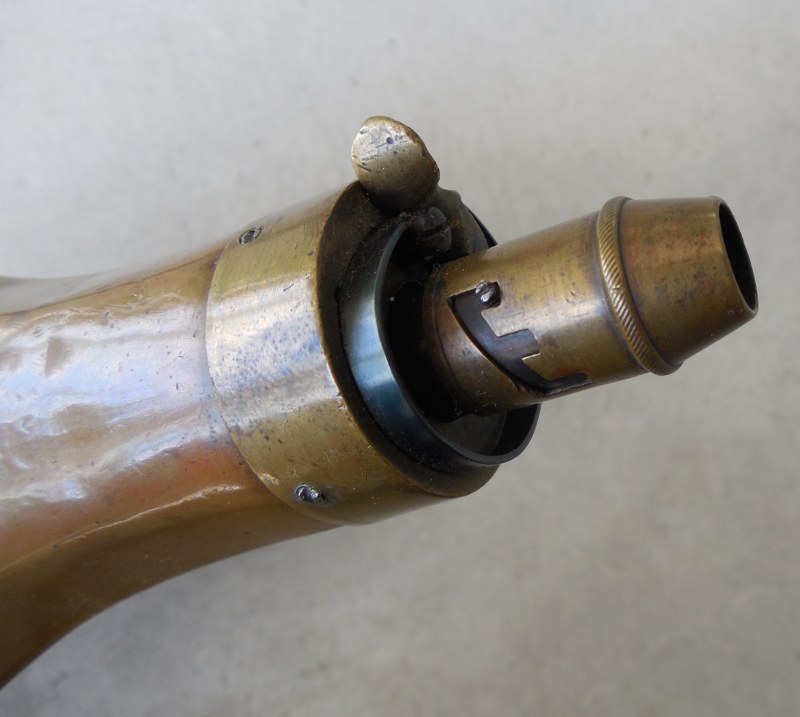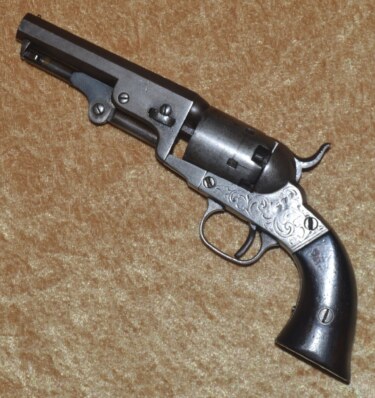Description
One of the rarest firearms is this fancy English gun given to high ranking chiefs by the
American Fur Company. William Chance & Son of Birmingham, England (1800-1846)
made only a handful of these fancy chief’s guns. Between 1831 and 1849 the American
Fur Company, founded by John Jacob Astor, ordered only 36 of these guns. According
to a publication by the Museum of the Fur Trade (Quarterly Vol. 34, Number 4, Winter
1998) one of these is reputed to have been carried by Blackhawk. This gun features a
flat lock plate marked vertically at the rear “W. CHANCE/& SON”, with a worn
gravestone fox with tail erect over the initials “IA” (for John Jacob Astor) in front of the
cock. Fancy three-screw brass serpentine side plate. The 42″ octagonal to round .62
cal. barrel is marked “LONDON”, with Birmingham proofs and a grave stone sitting fox;
engraved tang; with two inlayed bands around the breach (one brass and the other
silver). The unique front sight is a silver arrow through a silver disc. About ½” has been
cut from the muzzle, which was common with Indian guns which were commonly over
loaded. Walnut full stock with checkered wrist; no damage or repairs. These chief’s
guns all had unique inlays. This example features a silver dog escutcheon on the wrist,
a silver flower on the underside of the butt, and three barrel pins with silver escutcheons.
Brass mounts include butt plate engraved with boar’s head; an arrow and feathers; fancy
trigger guard with engraved pineapple, shield, and vines; three decorative ramrod
thimbles; and original brass-tipped wood ramrod. This gun shows honest use, but is in
its original state. The percussion ignition system was in its infancy at this time and the
maker, William Chance, was known for his early percussion guns. While the lockplate
does look like it may have originally been designed for flintlock use, it shows no sign of
ever having a frizzen and certainly it left Chance’s workshop in its current percussion
configuration. Included with the gun and purchased at the same time from the private
owner is a rare brass powder flask known as the “Indian Hunter” by Joseph Batty of
Sheffield, England, ca. 1798-1828. These flasks were made especially as gifts and
trade pieces for the Indian tribes.
Black Hawk, born Ma-ka-tai-me-she-kia-kiak, (1767 – October 3, 1838) was a war band
leader and warrior of the Sauk American Indian tribe in the Midwest. He was born in
Saukenuk, near present day Rock Island, Illinois. He was not a hereditary civil chief, but
earned his status as a war chief by his actions, beginning with his first kill and scalping at
the age of 15. During the War of 1812 he sided with the British, who made him a brevet
brigadier general in command of all native tribes in British service. During the war Black
Hawk fought in several major engagements with Major-General Henry Procter around
Lake Erie. Becoming disillusioned with the loss of life he associated with European
military tactics, he returned home to Saukenuk, but rejoined the British near the end of
the war in actions near the Mississippi. After the war he signed a peace treaty.
Black Hawk is best remembered for the war which bears his name. He did not
recognize the validity of the Treaty of 1804 which had ceded the Sauk and Fox lands in
Illinois. In April of 1832, encouraged by support from neighboring tribes and from the
British, he raised a band of about 500 warriors and 1000 non-combatants and re-
entered Illinois, picking up allies as he went. After achieving some initial victories, he
was pursued and eventually brought to battle with Illinois and Michigan militias at the
mouth of the Bad Axe River in August. He was soundly defeated at the Battle of Bad
Axe by a group of soldiers, allied Indian tribes, and even a US gunboat, which resulted in
the deaths of hundreds of Sauk and Potawatomi men, women, and children. Black
Hawk survived the engagement, but surrendered at Prairie du Chien and was held in
captivity at Jefferson Barracks, near St, Louis. In April of 1833 he was taken east to
Washington, D.C., where he met with President Andrew Jackson and Secretary of War
Lewis Cass. Everywhere he went he was followed by huge crowds and lavished with
gifts, posing for numerous portraits. While the Black Hawk War lasted only a few
months and had relatively few combatants on both sides, it included notable historic
figures such as future presidents Abraham Lincoln and Zachary Taylor, military leader
Winfield Scott, and future Confederate President Jefferson Davis. Though it is
impossible to know whether or not this gun was used in the war, it certainly dates from
that period and was discovered in the area Black Hawk and his band traveled.
Near the end of his captivity in 1833, Black Hawk told his life story to government
interpreter Antoine LeClaire, which was quickly published as his autobiography and
became a best seller. In his later years, Black Hawk tried to reconcile with both
American settlers and his Sauk rivals, including his nemesis Keokuk.
While there are no known records indicating how or when Black Hawk received this gun,
due to its markings it is unquestionably one of the 36 fancy chief’s guns made especially
for the American Fur Company between 1831 and 1849. It is possible that it was a gift
from George Davenport who was known to be a close friend, neighbor, and
acquaintance of many years. Davenport, one of the first settlers of Rock Island, lived
only 2 miles from Black Hawk’s home and in 1826 took a position with Astor’s American
Fur Company, which he held until after Black Hawk’s death. In 1835 he and several
others, including close friend and Black Hawk biographer Antoine LeClaire, purchased a
large tract of land on the Mississippi adjacent to Black Hawk’s village of Saukenuk,
which officially became Davenport, Iowa on Feb. 23, 1836. In 1838, the year of Black
Hawk’s death, Davenport became a U.S. Indian agent representing the Sauk and Fox
tribes and helped negotiate the 1842 treaty for the sale of their Iowa land to the Iowa
Territory. Davenport’s home on Rock Island, built in 1833, is still standing and is a
museum open to the public.
More research may be required to prove beyond doubt that this gun and flask were
owned by Blackhawk, but all the evidence supports its belonging to the famous chief. It
was obtained in 1979, along with the flask, from a rural family in Reedsburg, Wisconsin,
which is along Black Hawk’s retreat route after his defeat at the Battle of Wisconsin
Heights and before his final defeat at the Battle of Bad Axe along the Mississippi. The
seller concluded the deal for a modest sum before ever mentioning that it had belonged
to Black Hawk and was certainly unaware that this was one of only a handful of guns
which could have been the one reputedly carried by him.
This exact gun and powder flask are featured in Lar Hothem’s “Rare and Unusual
Indian Artifacts”, pages 273 & 274, with several photos, a description, and an
estimated value of $150,000. Included is a notarized affidavit from the original
purchaser (a retired FBI agent) indicating how and where the gun and flask were
obtained.
PRICE ON REQUEST
























 French and Indian Wars/Revolutionary War Era Spiked Tomahawk
French and Indian Wars/Revolutionary War Era Spiked Tomahawk  Manhattan Series I Pocket Revolver, Civil War Era
Manhattan Series I Pocket Revolver, Civil War Era  Exquisite North Italian (Brescia) Flintlock Pistol, ca. 1650
Exquisite North Italian (Brescia) Flintlock Pistol, ca. 1650  Civil War Era Manhattan Series I Pocket Pistol
Civil War Era Manhattan Series I Pocket Pistol